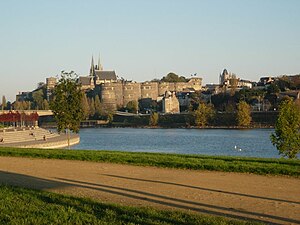Siege of Angers
| Siege of Angers | |||||||
|---|---|---|---|---|---|---|---|
| Part of the War in the Vendée | |||||||
 Angers Castle |
|||||||
|
|||||||
| Belligerents | |||||||
|
|
' |
||||||
| Commanders and leaders | |||||||
| • Louis Thévenet • Jean-Pierre Boucret • Michel de Beaupuy • Jean Bouin de Marigny |
• Henri de La Rochejaquelein • Jean-Nicolas Stofflet |
||||||
| Strength | |||||||
| 4 000 men | 15 000 to 20 000 men | ||||||
| Casualties and losses | |||||||
| 400 killed or wounded | 800 killed, 1200 wounded | ||||||
The Siege of Angers was a siege of the French town of Angers on 3 December 1793 in the War in the Vendée.
Pushed back at Granville, the Vendéens hoped to reach the south of the Loire to which the path was open thanks to their victory in the Battle of Dol. On 23 November, the Vendéen generals met at Antrain. The chief general Henri de La Rochejaquelein offered to march to Rennes where the republican army had sought refuge, in order to finish it off and free Brittany, the army could then attack Nantes to return to Vendée while meeting with Charette's army. On the other hand, Stofflet wanted to return by the shortest road, thus attacking Angers. Finally, Antoine-Philippe de La Trémoille wanted to attack Granville again, the town's garrison was reduced and the English seemed more willing to intervene there. This last plan was chosen by the officers, but the Vendéen soldiers refused to obey and rather followed Stofflet's plan. The generals were forced to follow.
The army thus marched to Angers. The Vendéens were no longer worried about the republican troops too busy reorganizing their forces, but they were ravaged by illnesses (dysentery, typhus and cholera) related to famine caused by their difficulties in supply and in protecting themselves from the cold of the upcoming winter.
...
Wikipedia
